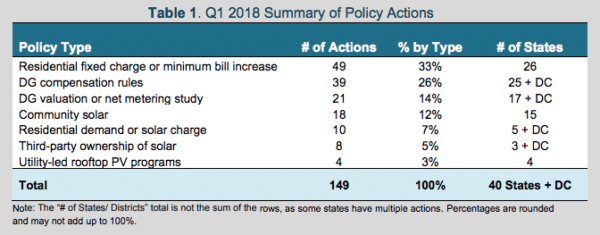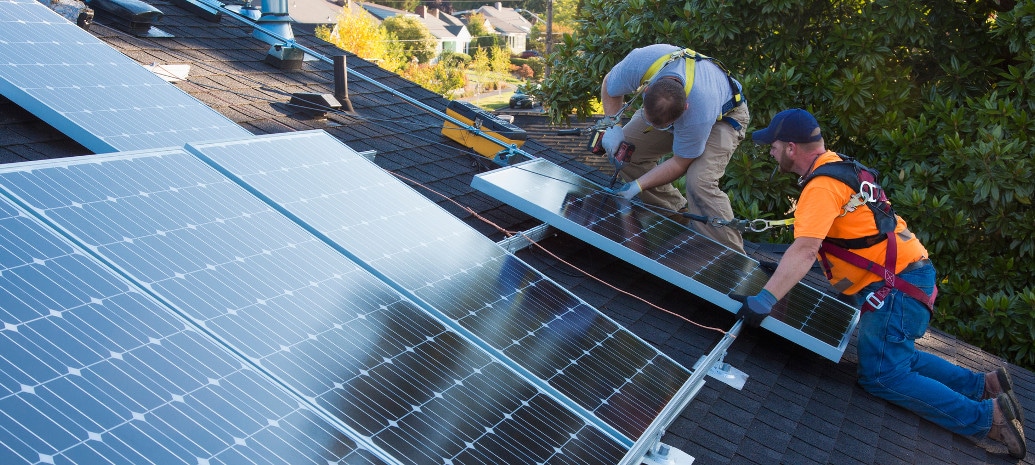When looking at the state of policies for distributed solar, it can be hard sometimes to see the forest for the trees. Negative news tends to get bigger headlines, and it can be hard to see the overall direction of policy across the United States when bogged down in the details of conflicts in only a few states.
For a look at the national picture, North Carolina Clean Energy Technology Center’s (NCCETC) quarterly 50 States of Solar report can be a good place to start. The report looks at the sum of policy actions in all states, which can show broader trends.
The Q1 2018 edition of the report shows that utilities are continuing their attempts to claw back more revenue from customer-sited solar and weaken its economics, both through dismantling of net metering and attempting to impose fixed and demand charges.
The report finds 49 actions taken in 26 states related to residential fixed charges or minimum bill increases, the same number as in Q4. It also found 39 actions taken on DG compensation rules in 26 states plus Washington DC – again the same number as Q4. Both numbers are increases from Q3 2017.

Taken from the report executive summary
Utility victories, rooftop solar losses
But while previous editions of the report found that utilities weren’t getting all that they asked for – or in many cases even most of what they want – the Q1 report details several policies that are of significant concern to the solar industry.
Topping the list is the “net metering successor” proposed by the Michigan Public Service Commission. This is a dry way to refer to what was finalized last week. On April 18 state regulators scrapped net metering and replaced retail reimbursement with one based on avoided cost payments for all electricity not immediately consumed on-site – in contrast to most net metering policies which calculate surplus generation monthly. This will doubtless wreck the economics of customer-sited solar and kill the state’s nascent distributed solar industry.
Second from the top is a move by regulators in the otherwise solar-friendly state of Massachusetts to allow utility Eversource to impose a demand charge on customers with net-metered solar at their homes. While utilities have been pushing for this for some time, this is the first time that a state regulatory agency has allowed a demand charge on residential customers, and as such can be seen as a major step backwards not only for the Bay State, but for solar policy nationally.
There were a number of other policy changes detailed. But as NCCETC does not appear to track what didn’t happen, it’s top solar policy changes do not include the narrow upholding of a veto by Maine Governor LePage (R) of a bill that would have fixed a key aspect of the dismantling of net metering in that state – which incidentally was implemented by regulators LePage appointed.
If anything, the policy changes in Maine were worse than Michigan. Michigan regulators at least paid lip service to some sort of process to value the contribution of distributed resources, even if their final ruling did not reflect this. Additionally their assessment of basing the value of electricity from solar at avoided cost has some logic to it, even as it misses key inputs. By contrast Maine is arbitrarily lowering the value attributed to electricity generated by solar and returned to the grid, in a transparent bid to kill rooftop solar in the state.
It is notable that all three states – Michigan, Maine and Massachusetts – have electricity sector regulators who were appointed by Republican governors. In the case of Maine and Michigan, these governors have played a direct role in legislation to enable the scrapping of net metering.
However, Connecticut’s Senate is also considering a bill to scrap net metering, which is supported by Democratic leadership in the state’s legislature.
Broader discussions of DER
In a press statement accompanying the report, NCCETC does not focus on these setbacks, but rather notes that discussions around policy and rate design are stretching to encompass not only solar but batteries, electric vehicles and other distributed energy resources (DER). Along with this, the organization says that the discussion is looking at a broader set of policy designs.
“We are seeing a broadening of the conversation across the country, both from a technology and policy perspective,” said Brian Lips, NCCETC’s senior policy project manager. “Today, states are considering a range of solar compensation structures and program designs, with states acting as laboratories of innovation to explore the range of available options.”
Correction: This article was corrected at 1:55 PM EST on April 26. A previous version of the article stated that Michigan had moved to a buy-all, sell-all model, which was incorrect. The state is merely applying a tariff based on avoided cost to all surplus generation. Our analysis that this will wreck the economics of customer-sited solar and kill the state’s distributed solar industry stands. Additionally, the ruling was on April 18, not April 19.
This content is protected by copyright and may not be reused. If you want to cooperate with us and would like to reuse some of our content, please contact: editors@pv-magazine.com.









Having followed residential solars development since the days of the Mother Earth solar box collector and the promise of energy independence for the residential ratepayer; I have found the technical progress and the political resistance a great social example of monopolistic control of American finance as it concerns the majority of American consumers.
The final jury decision?
If there is a mechanism that will empower the American middle class to divorce itself from economic control as it concerns energy consumption; there is no freedom of choice.
My next home will be off grid. Period.
… while there are good reasons to go off grid there are also good reasons to work for transition to “consumer-centric” business models. ConEd in New York state is embracing this approach and looks to be having success.
It’s interesting to note how at the same time the electric utilities in these states are hard at it protecting their for-profit monopolies, the coal and nuclear industries are working to have FERC re-work the wholesale pricing markets to allow them have favored pricing as generation sources in the name of “grid resiliency”. Their coal and nuclear plants are all old and uneconomical to operate without more and more subsidies.
Once natural gas starts going back up in price as the fracking glut disappears and people see just how quickly fracked wells deplete, there is going to be significant price pain in the energy markets. For anyone who does not believe just how volatile natural gas pricing can be, just look at its history.